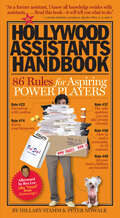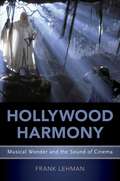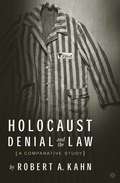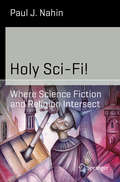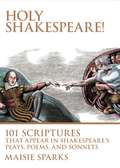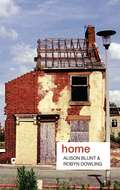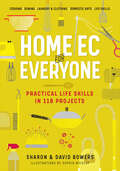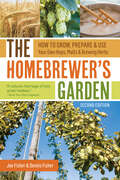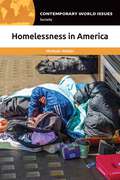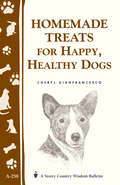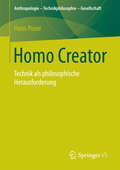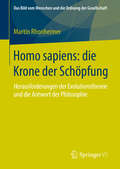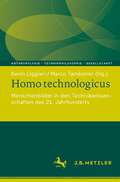- Table View
- List View
The Hollywood Assistants Handbook: 86 Rules for Aspiring Power Players
by Peter Nowalk Hillary StammAre you young, eager, smart, and heading off to LA to make it big in the entertainment business? Time for a reality check: Leave your diploma at home, put your grandiose dreams on hold (where hopefully they'll get tired and hang up), and start by repeating the first rule of the industry: Who you work for is more important than who you are. Then leapfrog over everyone else by reading The Hollywood Assistants Handbook. Written by two very sharp and successful assistants to HPPs (Hollywood Power Players), here are 86 lessons packed with a combination of blunt truth, insider humor, and juicy secrets that explain the unwritten rules of how to get a foot in the door and make all the right moves as you climb to the top. Here are the minimum-wage jobs that will put you in the path of HPPs. An annotated resume roundup. The clubs to frequent and the cocktails to order. Movies to watch and books to read (it's called homework). Dressing do's and don'ts. How to get on the Free List. A lineup of boss genres—the Horror Show, the Romantic Comedy, Mr. Action—and how to dodge the tirades that will soon be hurled your way, along with the proper outlets for venting. Plus, the ins and outs of your most important tool, the telephone—when to listen in (always!), who to put through and who to put off, and your new best friend forever, the Plantronics CS70 cordless headset. With its hilariously snarky tone—the gate-keeping quiz is "How to Tell if You're a Moron Who Should Pack Up the Corolla and Move Back Home"—The Hollywood Assistants Handbook is as baldly entertaining for everyone who loves reading about Hollywood as it is indispensably practical for the job-seeker.
Hollywood Catwalk: Exploring Costume and Transformation in American Film (International Library Of Cultural Studies)
by Tamar Jeffers McDonaldThe High School outsider takes off her glasses, puts on a dress, and becomes the Prom Queen; the dowdy woman has her hair done, buys some chic new clothes and starts to attract the men. Cinderella and Pygmalion stories still provide inspiration for the plots of Hollywood romantic comedies, dramas, and even action films. Their perennial use prompts a series of questions: is, for example, male agency necessary to effect the transformation, or can the woman change herself? Can she ever change him? Most pressingly, what do these images of change and transformation, of improvement and transcendence tell us, the viewers, about what we should be doing? Investigating these questions, this book examines a key but frequently overlooked aspect of film style: the costume. Across all the films discussed, costume and the body it covers becomes the crucial element in the transformation scene, exemplifying the “before” and “after” of the successful change. Exploring the fantasies of transcendence and transformation sold through these films and exemplified in the costumes, this book examines 'Calamity Jane', 'Midnight Cowboy', 'Clueless', 'The Long Kiss Goodnight', 'The Devil Wears Prada', and many other examples from both classic and contemporary Hollywood.
Hollywood Harmony: Musical Wonder and the Sound of Cinema (Oxford Music/Media Series)
by Frank LehmanFilm music often tells us how to feel, but it also guides us how to hear. Filmgoing is an intensely musical experience, one in which the soundtrack structures our interpretations and steers our emotions. Hollywood Harmony explores the inner workings of film music, bringing together tools from music theory, musicology, and music psychology in this first ever book-length analytical study of this culturally central repertoire. Harmony, and especially chromaticism, is emblematic of the "film music sound," and it is often used to evoke that most cinematic of feelings-wonder. To help parse this familiar but complex musical style, Hollywood Harmony offers a first-of-its kind introduction to neo-Riemannian theory, a recently developed and versatile method of understanding music as a dynamic and transformational process, rather than a series of inert notes on a page. This application of neo-Riemannian theory to film music is perfect way in for curious newcomers, while also constituting significant scholarly contribution to the larger discipline of music theory. Author Frank Lehman draws from his extensive knowledge of cinematic history with case-studies that range from classics of Golden Age Hollywood to massive contemporary franchises to obscure cult-films. Special emphasis is placed on scores for major blockbusters such as Lord of the Rings, Star Wars, and Inception. With over a hundred meticulously transcribed music examples and more than two hundred individual movies discussed, Hollywood Harmony will fascinate any fan of film and music.
HOLLYWOOD HARMONY OMMS C: Musical Wonder and the Sound of Cinema (Oxford Music/Media Series)
by Frank LehmanFilm music often tells us how to feel, but it also guides us how to hear. Filmgoing is an intensely musical experience, one in which the soundtrack structures our interpretations and steers our emotions. Hollywood Harmony explores the inner workings of film music, bringing together tools from music theory, musicology, and music psychology in this first ever book-length analytical study of this culturally central repertoire. Harmony, and especially chromaticism, is emblematic of the "film music sound," and it is often used to evoke that most cinematic of feelings-wonder. To help parse this familiar but complex musical style, Hollywood Harmony offers a first-of-its kind introduction to neo-Riemannian theory, a recently developed and versatile method of understanding music as a dynamic and transformational process, rather than a series of inert notes on a page. This application of neo-Riemannian theory to film music is perfect way in for curious newcomers, while also constituting significant scholarly contribution to the larger discipline of music theory. Author Frank Lehman draws from his extensive knowledge of cinematic history with case-studies that range from classics of Golden Age Hollywood to massive contemporary franchises to obscure cult-films. Special emphasis is placed on scores for major blockbusters such as Lord of the Rings, Star Wars, and Inception. With over a hundred meticulously transcribed music examples and more than two hundred individual movies discussed, Hollywood Harmony will fascinate any fan of film and music.
Holocaust Denial and the Law: A Comparative Study
by R. KahnFrom 1978-1996 Holocaust denial emerged as a major concern for the liberal democracies of Europe and North America. This period also saw the first prosecutions of Holocaust deniers. But these prosecutions often ran into trouble. Holocaust Denial and the Law relates how courts in four countries (Canada, France, Germany and the United States) resolved the dilemmas posed by Holocaust-denial litigation. It also describes how, in the United States, student editors had to decide whether to run ads denying the Holocaust. The book concludes that a given country's resolution of these dilemmas turns on its specific legal traditions and historical experiences.
Holy Sci-Fi!: Where Science Fiction and Religion Intersect (Science and Fiction)
by Paul J. NahinCan a computer have a soul? Are religion and science mutually exclusive? Is there really such a thing as free will? If you could time travel to visit Jesus, would you (and should you)? For hundreds of years, philosophers, scientists and science fiction writers have pondered these questions and many more.In Holy Sci-Fi!, popular writer Paul Nahin explores the fertile and sometimes uneasy relationship between science fiction and religion. With a scope spanning the history of religion, philosophy and literature, Nahin follows religious themes in science fiction from Feynman to Foucault and from Asimov to Aristotle.An intriguing journey through popular and well-loved books and stories, Holy Sci-Fi! shows how sci-fi has informed humanity's attitudes towards our faiths, our future and ourselves.
Holy Shakespeare!: 101 Scriptures That Appear in Shakespeare's Plays, Poems, and Sonnets
by Maisie Sparks101 lines or passages from William Shakespeare's works paired with Scripture passages that appear in the bard's classics. To be published just in time for the Shakespeare 400th celebrations.Shakespeare was heavily influenced by Holy Writ. Bible lines, characters and narratives are "verbal characters" in the his plays, poems and sonnets, sometimes subtly and sometimes blatantly. But they are there, revealing the deep scriptural well that was the culture from which Shakespeare drew and also reminding us of scenes and stories in the Bible. Shakespeare knew the Bible--as did everyone during that time. He used Scripture freely in what he wrote because through such biblical allusions, audiences would immediately grasp his meanings, charaterizations and unfolding situations. His works-meant to be performed-gave Scripture life. The Bible was not mere words in Shakespeare's work, but, like all of Scripture, were used for reproof, instruction, conviction and training. Listening to Shakespeare with an ear that's open to whispers from God's Word can kindle both passion for his great literary works and the Greatest Book of all, Holy Scripture.
Home
by Alison Blunt Robyn Dowling‘Home’ is a significant geographical and social concept. It is not only a three-dimensional structure, a shelter, but it is also a matrix of social relations and has wide symbolic and ideological meanings; home can be feelings of belonging or of alienation; feelings of home can be stretched across the world, connected to a nation or attached to a house; the spaces and imaginaries of home are central to the construction of people’s identities. An essential guide to studying home and domesticity, this book locates ‘home’ within wider traditions of thought. It analyzes different sources, methods and examples in both historical and contemporary contexts; ranging from homes on the American frontier and imperial domesticity in British India, to Australian suburbs, multicultural London, and South Asian diasporic homes. The core argument of the book has three main parts that cut across each of its chapters: home-making identity and belonging homely and unhomely spaces. Each chapter includes text boxes and exercises and is well illustrated with cartoons, line drawings, and photographs. Outlining the social relations shaping, (and being influenced by) the geographies of home; and the imaginative as well as material importance of home, this book will be a valuable reference for students of geography, sociology, gender studies, and those interested in the home and domesticity.
Home
by Alison Blunt Robyn Dowling‘Home’ is a significant geographical and social concept. It is not only a three-dimensional structure, a shelter, but it is also a matrix of social relations and has wide symbolic and ideological meanings; home can be feelings of belonging or of alienation; feelings of home can be stretched across the world, connected to a nation or attached to a house; the spaces and imaginaries of home are central to the construction of people’s identities. An essential guide to studying home and domesticity, this book locates ‘home’ within wider traditions of thought. It analyzes different sources, methods and examples in both historical and contemporary contexts; ranging from homes on the American frontier and imperial domesticity in British India, to Australian suburbs, multicultural London, and South Asian diasporic homes. The core argument of the book has three main parts that cut across each of its chapters: home-making identity and belonging homely and unhomely spaces. Each chapter includes text boxes and exercises and is well illustrated with cartoons, line drawings, and photographs. Outlining the social relations shaping, (and being influenced by) the geographies of home; and the imaginative as well as material importance of home, this book will be a valuable reference for students of geography, sociology, gender studies, and those interested in the home and domesticity.
Home (Key Ideas in Geography)
by Alison Blunt Robyn DowlingHome articulates a ‘critical geography of home’ in which home is understood as an emotive place and spatial imaginary that encompasses lived experiences of everyday, domestic life alongside a wider, and often contested, sense of being and belonging in the world. Engaging with the burgeoning cross-disciplinary interest in home since the first edition was published, this significantly revised and updated second edition contains new research boxes, illustrations, and contemporary examples throughout. It also adds a new chapter on ‘Home and the City’ that extends the scalar understanding of home to the urban. The book develops the conceptual and methodological underpinnings of a critical geography of home, drawing on key feminist, postcolonial, and housing thinkers as well as contemporary methodological currents in non-representational thinking and performance. The book’s chapters consider the making and unmaking of home across the domestic scale – house-as-home; the urban – city-as-home; national – nation-as-home; and homemaking in relation to transnational migration and diaspora. Each chapter includes illustrative examples from diverse geographical contexts and historical time periods. Chapters also address some of the key cross-cutting dimensions of home across these scales, including digital connectivity, art and performance, more-than-human constructions of home, and violence and dispossession. The book ends with a research agenda for home in a world of COVID-19. The book provides an understanding of home that has three intersecting dimensions: that material and imaginative geographies of home are closely intertwined; that home, power, and identity are intimately linked; and that geographies of home are multi-scalar. This framework, the examples used to illustrate it, and the intended audience of academics and students across the humanities and social sciences will together shape the field of home studies into the future.
Home (Key Ideas in Geography)
by Alison Blunt Robyn DowlingHome articulates a ‘critical geography of home’ in which home is understood as an emotive place and spatial imaginary that encompasses lived experiences of everyday, domestic life alongside a wider, and often contested, sense of being and belonging in the world. Engaging with the burgeoning cross-disciplinary interest in home since the first edition was published, this significantly revised and updated second edition contains new research boxes, illustrations, and contemporary examples throughout. It also adds a new chapter on ‘Home and the City’ that extends the scalar understanding of home to the urban. The book develops the conceptual and methodological underpinnings of a critical geography of home, drawing on key feminist, postcolonial, and housing thinkers as well as contemporary methodological currents in non-representational thinking and performance. The book’s chapters consider the making and unmaking of home across the domestic scale – house-as-home; the urban – city-as-home; national – nation-as-home; and homemaking in relation to transnational migration and diaspora. Each chapter includes illustrative examples from diverse geographical contexts and historical time periods. Chapters also address some of the key cross-cutting dimensions of home across these scales, including digital connectivity, art and performance, more-than-human constructions of home, and violence and dispossession. The book ends with a research agenda for home in a world of COVID-19. The book provides an understanding of home that has three intersecting dimensions: that material and imaginative geographies of home are closely intertwined; that home, power, and identity are intimately linked; and that geographies of home are multi-scalar. This framework, the examples used to illustrate it, and the intended audience of academics and students across the humanities and social sciences will together shape the field of home studies into the future.
Home: Small Home, Work From Home, Rented Home
by Kate Watson-SmythHome: The Way We Live Now is an innovative new sourcebook for modern living. Interiors expert Kate Watson-Smyth looks beyond the estate agent's floorplan and shows how to use the space you have to revolutionise the way you live, whether you own or rent.
Home Ec for Everyone: Cooking · Sewing · Laundry & Clothing · Domestic Arts · Life Skills
by Sharon Bowers David BowersClear step-by-step instructions for everything you would have been taught in Home Ec class: cooking and baking, sewing and mending, home-keeping tips, and more--in a stylish and easy-to-use reference guide for today's DIY'ers, homeowners and renters, new adults, and anyone who wants to be more self-sufficient at home.
Home Hacks: Handy Hints to Make Life Easier (Life Hacks Ser.)
by Dan MarshallDozens of everyday household dilemmas are solved with HOUSEHOLD HACKS, your handy guide to tackling little domestic annoyances, cheaply and swiftly, so you can get on with something more fun. This fully illustrated manual covers everything from ingenious space-saving storage solutions, clever cleaning hacks, DIY and much, much more.
Home Maintenance For Dummies
by Tom KraeutlerTake the intimidation out of common home repair jobs Home Maintenance For Dummies gives you the know-how you need to inspect, tune up, and make repairs to every room of your house. Learn how to stop drafty windows and doors, fix roof leaks, unclog pipes, silence squeaky floors, test your water pressure, fix a dripping faucet, and beyond. Plus, learn tricks of the trade to stop wasting energy, lower energy bills, and improve the comfort of your home. Some home maintenance jobs are easy to ignore, but you'll save thousands in repair costs if you keep things running properly. And when things do break, you can save even more money with DIY repairs. You'll be amazed how easy it is to do many common upkeep tasks yourself. With step-by-step guides, detailed diagrams, and instructions for every room of the home, you'll finally be able to fix those little problems that have been nagging at you. This updated edition covers the latest heating and cooling systems, tankless water heaters, LED lighting, solar power, and all the other newfangled stuff in your house. Learn how to conduct routine inspections, keep major appliances running efficiently, and avoid costly mistakes Make a list for the must-have tools in your toolbox Recognize the difference between an easy DIY repair and something an expert should handle Protect your home from long-term problems and secure the value of your asset First-time homeowners looking for a guide to keep their dream home in tip-top shape, as well as homeowners who aren't familiar with common home repairs, will love this beginner-friendly Dummies guide.
Home Maintenance For Dummies
by Tom KraeutlerTake the intimidation out of common home repair jobs Home Maintenance For Dummies gives you the know-how you need to inspect, tune up, and make repairs to every room of your house. Learn how to stop drafty windows and doors, fix roof leaks, unclog pipes, silence squeaky floors, test your water pressure, fix a dripping faucet, and beyond. Plus, learn tricks of the trade to stop wasting energy, lower energy bills, and improve the comfort of your home. Some home maintenance jobs are easy to ignore, but you'll save thousands in repair costs if you keep things running properly. And when things do break, you can save even more money with DIY repairs. You'll be amazed how easy it is to do many common upkeep tasks yourself. With step-by-step guides, detailed diagrams, and instructions for every room of the home, you'll finally be able to fix those little problems that have been nagging at you. This updated edition covers the latest heating and cooling systems, tankless water heaters, LED lighting, solar power, and all the other newfangled stuff in your house. Learn how to conduct routine inspections, keep major appliances running efficiently, and avoid costly mistakes Make a list for the must-have tools in your toolbox Recognize the difference between an easy DIY repair and something an expert should handle Protect your home from long-term problems and secure the value of your asset First-time homeowners looking for a guide to keep their dream home in tip-top shape, as well as homeowners who aren't familiar with common home repairs, will love this beginner-friendly Dummies guide.
The Homebrewer's Answer Book: Solutions to Every Problem, Answers to Every Question
by Ashton LewisAshton Lewis supplies practical, easy-to-follow answers to all the questions that bubble up in the course of brewing your own beer. Covering all stages of the homebrew process, Lewis provides expert advice on buying hops, sanitizing your equipment, troubleshooting unpleasant flavors, the best way to pour beer into a glass, and much more. This comprehensive guide will help you understand brewing chemistry, fix problems, and achieve the flavor and balance you want in all of your handcrafted beers.
The Homebrewer's Garden, 2nd Edition: How to Grow, Prepare & Use Your Own Hops, Malts & Brewing Herbs
by Joe Fisher Dennis FisherIf you have a backyard, or even a sunny porch or balcony, you can grow your own hops, brewing herbs, and malt grains to enhance the flavor, aroma, and uniqueness of your home-brewed beer — and ensure that you have the freshest, purest, best ingredients possible. Simple instructions from experts Joe and Dennis Fisher guide you through every step of the process, from setting up your first hop trellis to planting and caring for your herbs, harvesting and drying them, malting grain, and brewing more than 25 recipes specifically designed for homegrown ingredients. This fully updated second edition includes a new section featuring color photography of the plants, expanded information on growing hops in small spaces, innovative trellising ideas, an expanded section on malting, new profiles of prominent grower/brewers, and up-to-date information on grain-growing best practices.
Homelessness in America: A Reference Handbook (Contemporary World Issues)
by Michele WakinThis title provides a one-stop resource for understanding the crisis of homelessness in the United States. It covers risk factors for homelessness, societal attitudes about the homeless, and public and private resources designed to prevent homelessness and help those in need.There are a number of questions to be answered when addressing the subject of homelessness in the United States. What are the primary causes of homelessness? What are the economic and socioeconomic factors that have an impact on homeless people? What demographic trends can be identified in homeless populations? Is the U.S. addressing the needs and concerns of homeless people adequately? Where are the areas with the highest homeless populations? What can be done to help homeless people who live with mental illness and/or addiction problems?Homelessness in America: A Reference Handbook answers all of these questions and more. It thoroughly examines the history of homelessness in the U.S., shining a light on the key issues, events, policies, and attitudes that contribute to homelessness and shape the experience of being homeless. It places special emphasis on exploring the myriad problems that force people into homelessness, such as inadequate levels of affordable housing, struggles with substance abuse, and gaps in the U.S.' social welfare system. In addition, it explains why some demographic groups are at heightened risk of homelessness.
Homelessness in America: A Reference Handbook (Contemporary World Issues)
by Michele WakinThis title provides a one-stop resource for understanding the crisis of homelessness in the United States. It covers risk factors for homelessness, societal attitudes about the homeless, and public and private resources designed to prevent homelessness and help those in need.There are a number of questions to be answered when addressing the subject of homelessness in the United States. What are the primary causes of homelessness? What are the economic and socioeconomic factors that have an impact on homeless people? What demographic trends can be identified in homeless populations? Is the U.S. addressing the needs and concerns of homeless people adequately? Where are the areas with the highest homeless populations? What can be done to help homeless people who live with mental illness and/or addiction problems?Homelessness in America: A Reference Handbook answers all of these questions and more. It thoroughly examines the history of homelessness in the U.S., shining a light on the key issues, events, policies, and attitudes that contribute to homelessness and shape the experience of being homeless. It places special emphasis on exploring the myriad problems that force people into homelessness, such as inadequate levels of affordable housing, struggles with substance abuse, and gaps in the U.S.' social welfare system. In addition, it explains why some demographic groups are at heightened risk of homelessness.
Homemade Treats for Happy, Healthy Dogs: Delicious Homemade Treats For Happy, Healthy Dogs
by Cheryl GianfrancescoPamper Your Pup With All-Natural Taste Temptations!Treat your dog to the tastiest and healthiest biscuits and bones ever made for canine consumption! Cheryl Gianfrancesco’s easy-to-follow recipes call for only the best all-natural ingredients, and as your dog will agree, the results are fantastic. Could any dog resist Peanut Butter Biscuits, Cheese and Garlic Bites, Chicken and Cheese Biscuits, or Ginger Cookies? How about a Best-Friend Birthday Cake, complete with frosting? Homemade Treats for Happy, Healthy Dogs offers 50 recipes for the canine connoisseur of fine foods. If dogs could read, this would be their favorite cookbook!
Homeschooling the Child with Asperger Syndrome: Real Help for Parents Anywhere and On Any Budget
by Lise PylesPacked with inspiring ideas and tips that can be used with any curriculum and on any budget, Homeschooling the Child with Asperger Syndrome explains how to design a varied study programme built around the child's own interests, making use of simple material as well as computers and on-line resources.
Homo Creator: Technik als philosophische Herausforderung (Anthropologie – Technikphilosophie – Gesellschaft)
by Hans PoserTechnik bestimmt auf die mannigfaltigste Weise unser Leben und Zusammenleben. Obgleich sie von Platon und Aristoteles bis in das zwanzigste Jahrhundert in Einzelaspekten betrachtet worden ist, wurde sie erst in den letzten Jahrzehnten zu einem eigenständigen Gegenstand der Philosophie. Dennoch werden ihre philosophischen Probleme immer noch eher beiläufig behandelt. So geht es um die Klärung ganz zentraler und herausfordernder Aufgaben – von der menschlichen Schöpferkraft über eine Klärung, was ein technisches Artefakt ist, zum technischen Wissen, in all diesen Elementen verknüpft mit dem Verantwortungsproblem. Das Ziel ist eine Darstellung dieser faszinierenden philosophischen Fragen vor dem Hintergrund der Tradition.
Homo sapiens: Herausforderungen der Evolutionstheorie und die Antwort der Philosophie (Das Bild vom Menschen und die Ordnung der Gesellschaft #0)
by Martin RhonheimerDas Buch handelt von den Herausforderungen der Evolutionstheorie für unser Menschenbild. Es möchte darauf Antworten aus der Sicht der Philosophie bieten. Grundthese ist, dass der Mensch Höhepunkt und Ziel der Evolution ist. Diese These ist nicht nur philosophisch bedeutsam, sondern besitzt auch politische Brisanz. Gegenüber ihren religiösen Kritikern wird sowohl die Evolutionstheorie wie auch das klassische Menschenbild verteidigt und eine philosophisch reflektierte Konzeption vorgelegt, die naturwissenschaftliche, metaphysische, anthropologische und religionsphilosophische Aspekte kohärent zusammendenkt.
Homo technologicus: Menschenbilder in den Technikwissenschaften des 21. Jahrhunderts (Anthropologie – Technikphilosophie – Gesellschaft)
Das vorliegende Buch zielt darauf ab, die verschiedenen Konzeptionen des „Menschen“, die eng mit der Produktion von anthropologischem Wissen in einem technowissenschaftlichen Umfeld verbunden sind, zu untersuchen. Hierfür sollen historische und philosophische Perspektiven auf die anthropologische Frage, die den Technowissenschaften des 21. Jahrhunderts innewohnt, zusammen gebracht werden und ein Beitrag zur aktuellen historischen und philosophischen Debatte über die kognitiven, produktiven und anthropologischen Modi geleistet werden. Die unterschiedlichen Problematisierungen, die dabei relevant sind, drehen sich um die Fragen: Ist die technowissenschaftliche Wissensproduktion immer mit einem bestimmten Bild des Menschen verbunden? Inwieweit sind die zugeschriebenen Eigenschaften des Menschen konstitutiv für die Entwicklung der Technowissenschaft? Welche Rolle spielt das (vergeschlechtlichte) Konzept „Mensch“ in den modernen Wissenschaften? Und wie ändert sich das Menschenbild epistemologisch und praktisch?
